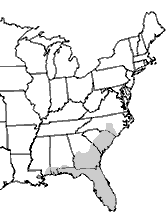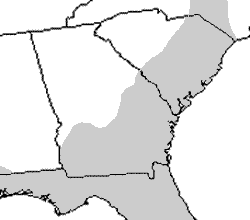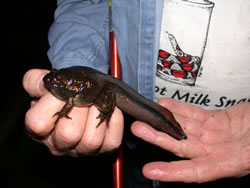River Frog (Rana [Lithobates] hecksheri)
![ranhec210 River Frog (Rana [Lithobates] hecksheri)](https://srelherp.uga.edu/wp-content/uploads/sites/70/2024/01/ranhec210.jpg)


Photos by J.D. Willson unless otherwise noted
| Description: Adult river frogs (Rana [Lithobates] heckscheri) are large frogs, ranging from 3 to 5 inches (7-13 cm) long. The record length is over 6 inches (15.5 cm). The dorsal surface can vary from green, dark green, to greenish black. The venter can be almost completely black, but is usually medium to dark gray. The belly also has short wavy lines or light spots. River frogs resemble Bullfrogs (Rana [L.] catesbeiana) and Pig Frogs (Rana [L.] grylio) but can be distinguished by the presence of light spots on the lips, particularly on the lower jaw. Males have a more yellowish throat than females. Also, the tympanum, or eardrum, is larger than the eye in males. In females, however, the tympanum is either the same size or smaller than the eye. River frogs have no dorsolateral ridges, which helps in characterizing it the similar Green Frog (Rana [L.] clamitans). The skin of river frogs is also more rugose than other ranid frogs, in other words the skin is rougher and heavily wrinkled. These frogs can also be identified by a pale girdle outlining the groin. Juveniles will have noticeably red eyes. Tadpoles are very large and have a conspicuous black margin on their tail fin.
Range and Habitat: River frogs are found the Coastal Plain of the southeastern United States, from southern North Carolina to Mississippi. They can be found in a variety of aquatic habitats but are most common along “blackwater” creeks and in cypress swamps. Habits: These frogs are nocturnal and are more easily approached than other frogs. Instead of fleeing, river frogs will often play dead and go limp or secrete an unpleasant odor. They breed from April to early August. The large tadpoles of river frogs can reach a size of up to 5 inches. The tadpoles also demonstrate schooling behavior, which is uncommon among frogs with large tadpoles. Call: The call of these frogs can be described as a deep, low-pitched, rolling snore. Conservation Status: River frogs are somewhat common in the southern Coastal Plain of the Georgia, where suitable habitat is still available. It has apparently declined in the east, though, and is believed extinct in North Carolina. Habitat loss is presumed to be the cause of these declines. There is no state or federal law protecting this species. The IUCN (Red List) Status for this species is LC (Least Concern). Pertinent References: Altig, R. 1981. Behavioral characteristics of the tadpoles of Rana heckscheri (Anura: Ranidae). Journal of Herpetology 15(2): 151-154. Account Author: Benjamin Morrison, University of Georgia – edited by J.D. Willson |

